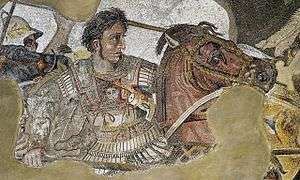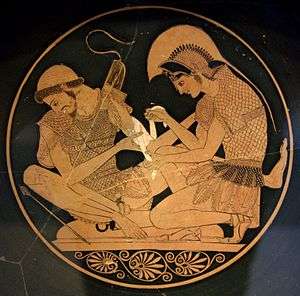Linothorax
The linothorax (pronounced /ˈliːnoʊθɔːræks/) is a type of upper body armor used by the ancient Greeks, as well as other Hellenic kingdoms including Macedonia, from the Mycenaean period through the Hellenistic period. The modern term linothorax is based on the Greek λινοθώραξ, which means "wearing a breastplate of linen"; the actual ancient term for this type of armour is unclear. The term "thorax" was the word for breastplate during this era and was traditionally made of metal in most contexts. The "linothorax" were made of linen glued in layers with animal fat, and eventually adopted by many armies. The earliest attested account of a linothorax used for battle is recorded in Book 2 of Homer's Iliad (2.529 and 2.830). It is worn by Ajax the Lesser and is described in brief. Homer, composing stories long before the great armies of Athens, Thebes, Sparta and Macedon, surely understood what the armor was. However, the extent to which it was used can not be fully determined as the texts were not accurate accounts of specific time periods. An educated guess can be made, however, based on its use by Alexander the Great, and its mention by other sources such as Herodotus (2.182, 3.47, 7.63), Livy (4.19.2–20.7), Strabo (Geography, 3.3.6, 13.1.10), and many other minor sources. The linothorax appears to have been used in place of the bronze “bell cuirass” as the popular choice of armour for Greek hoplites, starting perhaps around the late seventh century and early sixth century B.C. This could have been due to the lower price, lesser weight, and cooler material. Its high point in vase paintings, sculptural reliefs and artistic depictions corresponds with the time of the Persian Wars. By the time of the Peloponnesian War it was still used, and continued to seemingly flourish well into the Hellenistic period.
Construction
Very few details of the linothorax's construction are found in Homer and other authors of this era. The linen fabric was reinforced by a metal sheet around the waist, usually in a scale mail style, over a leather or felt cloth called zoma (ζῶμα) (Il. 23.683, 4.216, Od.14.482). Metal plates or flaps called pteryges (πτέρυγες) were protecting various parts of the body (Xenophon, Anabasis 4.7.15). A "zoster" (ζωστήρ) was a belt, probably of leather with metal plates, worn around the waist over the other parts of the cuirass (Il. 4.132, 135,186 etc.).[1]
The actual method of constructing a linothorax is unknown as no example has survived from ancient times. The only piece of armor that resembles the linothorax was discovered in a tomb in Vergina, Northern Greece (the ancient Macedonian capital of Aegae). This armor, which was most probably worn for ceremony, was constructed from sheet iron with gold embellishments. It is probably an iron copy of a linothorax.
Since visual evidence is limited to vase paintings and sculptural reliefs, rather than actual surviving models, modern scholars can only guess at its makeup and design. Artistic depictions show armor that has a top piece which covers the shoulders and is tied down on the chest, a main body piece wrapping around the wearer and covering the entire torso, and a row of pteruges or flaps around the bottom which cover the groin and upper thigh. There are a number of vase paintings that show what appear to be metal scales covering the armor (as shown in the picture).
The type of material that went into the construction of the linothorax is still hotly debated by academics and amateurs alike. Some of the more common theories of its construction involve laminated or quilting many layers of linen fabric (linothorax literally means 'linen torso'); the armor probably had between 12 and 20 layers. Some have claimed that it was made of leather, or possibly other materials, or a combination of both, but there is little evidence to either support or refute this. It has been suggested the fabric layers were bonded using animal glue. Although strong, this is water-soluble; therefore the armour would need protection against rain or sweat if this was indeed used.

Macedonian uses
The linothorax was used by many nations around the Mediterranean. The most known users of this style of chest plate was the army of Alexander the Great during the Hellenistic era. Such a light, cool material used for the armor would allow the Macedonians to keep cool in the hot, arid climates of Asia Minor. When recreated and tested by the University of Wisconsin-Green Bay, the linothorax was resistant to broad-head arrows and slashing damage of weapons with sharp edges. The bend of the fabric would allow the energy of the arrows to dissipate through the material and protect the user from lacerations. Blunt force trauma would still transfer through the armor, however, and possibly damage the internal organs of the soldier. This design would be very effective against the standard weapons of the Asia Minor armies: swords, spears, and light axes.
University of Wisconsin-Green Bay: Linothorax Project
In January 2009, Dr. Gregory S. Aldrete of the University of Wisconsin–Green Bay and Scott Bartell presented a paper discussing the protective qualities of the linothorax at the joint American Philological Association/Archaeological Institute of America Convention held in Philadelphia, Pennsylvania. The pair have been researching the linothorax since 2005 and have built a number of copies, using various methods that include lamination and quilting. Their paper argued that a 1 cm thick linothorax, usually consisting of around 11 to 18 layers (depending on thickness of thread), would have provided all the necessary protection to its wearer to survive an arrow or slashing attack.
The research was carried out by assembling dozens of linen test patches, arranged in a multitude of fashions, using authentic materials, and subjecting them to arrow shots and sword cuts. The testing was carried out in a sort of "worst-case-scenario" in which the range was nearly pointblank and the angle of archer to armor was perpendicular. In an actual battle both of these factors would have been considerably different, making the performance of the test patches even more remarkable. The tests also concluded that quilted armor offered roughly three quarters of the protection of laminated armor; thus the quilted patches were less effective. This was found to be true in every sort of test conducted. The research conducted by Greg Aldrete and Scott Bartell was also presented at the 2010 Poster Session for the Archaeological Institute of America (AIA) in Anaheim, California, where it won first prize among many contenders from around the world. The research is ongoing and is soon to be published.[2]
In use, the linothorax is stiff when first worn, but, through body heat, it conforms to the shape and movement of the user. This quality would have allowed it to be mass-produced for military use. In a warmer climate, bronze armor would be hot and thus decrease the wearer's ability to fight effectively for long periods.
On November 9, 2011, Dr. Aldrete was featured on an episode of Penn & Teller Tell a Lie—broadcast on the Discovery Channel—where he showed how the linothorax armor worked by shooting an arrow at one of his students, Scott Bartell.
See also
References
- Gregory S.; Scott Bartell; Alicia Aldrete. (2013). Ancient linen body armor : unraveling the linothorax mystery. Baltimore: Johns Hopkins University Press. ISBN 9781421408194.
External links
- University of Wisconsin-Green Bay: Linothorax Project
- Testing the Linothorax Video with Dr. Aldrete and Mr. Bartell
- Recreating the Linothorax
- Matthew Amt's Linothorax
- Discovery News Article on the 'UWGB Linothorax Project'
- Linothorax reconstructed by the "Koryvantes Association", Greece
